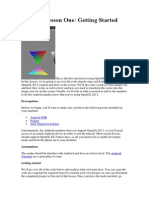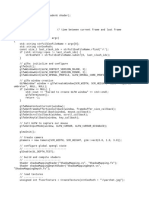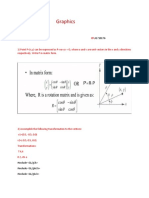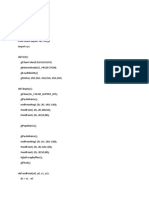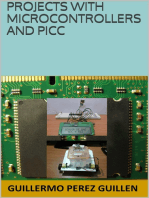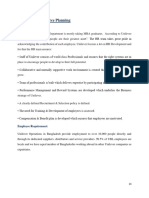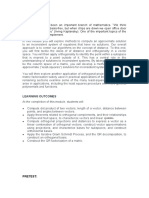OpenGL ES For Android Graphics Programming
Uploaded by
Ignacio Martinez RojasOpenGL ES For Android Graphics Programming
Uploaded by
Ignacio Martinez RojasOpenGL ES for Android Graphics Programming
Android offers support for 2D and 3D graphics with the OpenGL ES API. OpenGL ES is just a variation of OpenGL specifically designed for embedded systems. Since Android 1.0, the OpenGL ES 1.0 and 1.1 APIs have been included. The support for OpenGL ES 2.0 started from Android 2.2. This tutorial presents the basics for working on OpenGL ES software in Android by working through a few examples.
Android OpenGL References, Versions and Device Support
The Android OpenGL ES reference has version descriptions and comparisons among OpenGL ES 1.0/1.1 and 2.0. Since these versions differ in many ways, you should make your selection based on the performance, device compatibility, coding convenience, and graphics control for your implementation. To find out which OpenGL ES versions your current device supports, you can use the following code: String GL_RENDERER = gl.glGetString(GL10.GL_RENDERER); String GL_VERSION = gl.glGetString(GL10.GL_VERSION); ActivityManager am = (ActivityManager)getSystemService(Context.ACTIVITY_SER VICE); String GL_ES_VERSION = am.getDeviceConfigurationInfo().getGlEsVersion();
Android Classes for OpenGL GL
The two most important classes you need for OpenGL projects in Android are android.opengl.GLSurfaceView and android.opengl.GLSurfaceView.Renderer. You also must implement Renderer, an interface for the minimal required drawing methods, as follows: public void onSurfaceCreated(GL10 gl, EGLConfig config) public void onDrawFrame(GL10 gl) public void onSurfaceChanged(GL10 gl, int width, int
height) GLSurfaceView is a view class which you use to draw the graphics objects. You will also need it to capture user interaction events. Now you can instantiate this view class and call setRenderer with the renderer implementation you must provide.
OpenGL Geometric Elements, Rendering Primitives and Colors
Before we move on to our first example, there are some brief descriptions that should help you understand the code better if you are an OpenGL beginner. Geometric elements include points, lines, areas, and so on. For points, OpenGL uses gl.glVertexPointer to refer to the buffer for vertices contained in an array with X, Y, Z values. For lines, they are formed by connecting the indices from the vertex array. For areas, they are constructed by connecting oriented triangles. You can specify the vertex order used for the triangles with gl.glFrontFace(GL10.GL_CCW) for counter clockwise orientation or gl.glFrontFace(GL10.GL_CW) for clockwise. Rendering primitives include GL_POINTS for points. GL_LINES, GL_LINE_STRIP, and GL_LINE_LOOP are available for lines. For triangles, the options are GL_TRIANGLES, GL_TRIANGLE_STRIP, and GL_TRIANGLE_FAN. These can be rendered through gl.glDrawElements with their byte buffers provided. Basic coloring in Open GL contains four float values ranging from 0.0 to 1.0, representing Red, Green, Blue, and Alpha (Transparency) channels through gl.glColorf. For more complex coloring, we can create an array of the four float values and use gl.glColorPointer to refer to its byte buffer.
Build Your First Basic OpenGL ES Project in Android
As mentioned before, two essential classes required by all OpenGL ES projects are android.opengl.GLSurfaceView and android.opengl.GLSurfaceView.Renderer. Therefore, the main activity containing the minimal implementation is as follows: public class TutorialOnOpenGL extends Activity { private GLSurfaceView mView; private MyRenderer mRenderer; @Override public void onCreate(Bundle savedInstanceState) { super.onCreate(savedInstanceState); mView = new GLSurfaceView(this); mRenderer = new MyRenderer(this); mView.setRenderer(mRenderer);
setContentView(mView); } public boolean onTouchEvent(MotionEvent event) { return mRenderer.onTouchEvent(event); } } We will implement a Renderer interface with our own MyRenderer below. Because onSurfaceCreated, onSurfaceChanged and onTouchEvent will pretty much remain the same in other implementations, they will not be relisted later. This example basically has a list of five vertices representing a pyramid with vertex indices of 0, 1, 2, 3 at the base and 4 at the top.In setAllBuffers, each vertex component is a float value. Since a float value equals 4 bytes, byte buffer length needs to be multiplied by 4. Similarly, the border index is a short value and thus byte buffer length needs to be multiplied by 2. Border color is set to solid green. The main code to render all the lines is: gl.glDrawElements(GL10.GL_LINES, mNumOfTriangleBorderIndices, GL10.GL_UNSIGNED_SHORT, mTriangleBorderIndicesBuffer); Figure 1 shows the result, a wireframe pyramid. class MyRenderer implements Renderer { private Context mContext; private FloatBuffer mVertexBuffer = null; private ShortBuffer mTriangleBorderIndicesBuffer = null; private int mNumOfTriangleBorderIndices = 0; public float mAngleX = 0.0f; public float mAngleY = 0.0f; public float mAngleZ = 0.0f; private float mPreviousX; private float mPreviousY; private final float TOUCH_SCALE_FACTOR = 0.6f; public MyRenderer(Context context) { mContext = context; } public void onDrawFrame(GL10 gl) { gl.glClear(GL10.GL_COLOR_BUFFER_BIT | GL10.GL_DEPTH_BUFFER_BIT);
gl.glMatrixMode(GL10.GL_MODELVIEW); gl.glLoadIdentity(); gl.glTranslatef(0.0f, gl.glRotatef(mAngleX, gl.glRotatef(mAngleY, gl.glRotatef(mAngleZ, 0.0f, 1, 0, 0, 1, 0, 0, -3.0f); 0); 0); 1);
gl.glVertexPointer(3, GL10.GL_FLOAT, 0, mVertexBuffer); // Set line color to green 1.0f, 0.0f, 1.0f); gl.glColor4f(0.0f,
// Draw all lines gl.glDrawElements(GL10.GL_LINES, mNumOfTriangleBorderIndices, GL10.GL_UNSIGNED_SHORT, mTriangleBorderIndicesBuffer); } public void onSurfaceCreated(GL10 gl, EGLConfig config) { gl.glClearColor(0.0f, 0.0f, 0.0f, 0.0f); gl.glHint(GL10.GL_PERSPECTIVE_CORRECTION_HINT, GL10.GL_NICEST); gl.glEnable(GL10.GL_DEPTH_TEST); gl.glEnableClientState(GL10.GL_VERTEX_ARRAY); // Get all the buffers ready setAllBuffers(); } public void onSurfaceChanged(GL10 gl, int width, int height) { gl.glViewport(0, 0, width, height); float aspect = (float)width / height; gl.glMatrixMode(GL10.GL_PROJECTION); gl.glLoadIdentity(); gl.glFrustumf(-aspect, aspect, -1.0f, 1.0f, 1.0f, 10.0f); } private void setAllBuffers(){ // Set vertex buffer float vertexlist[] = { -1.0f, 0.0f, -1.0f, 1.0f, 0.0f, -1.0f,
-1.0f,
0.0f, 1.0f, 1.0f, 0.0f, 1.0f, 0.0f, 2.0f, 0.0f, }; ByteBuffer vbb = ByteBuffer.allocateDirect(vertexlist.length * 4); vbb.order(ByteOrder.nativeOrder()); mVertexBuffer = vbb.asFloatBuffer(); mVertexBuffer.put(vertexlist); mVertexBuffer.position(0); // Set triangle border buffer with vertex indices short trigborderindexlist[] = { 4, 0, 4, 1, 4, 2, 4, 3, 0, 1, 1, 3, 3, 2, 2, 0, 0, 3 }; mNumOfTriangleBorderIndices = trigborderindexlist.length; ByteBuffer tbibb = ByteBuffer.allocateDirect(trigborderindexlist.length * 2); tbibb.order(ByteOrder.nativeOrder()); mTriangleBorderIndicesBuffer = tbibb.asShortBuffer(); mTriangleBorderIndicesBuffer.put(trigborderindexlist); mTriangleBorderIndicesBuffer.position(0); } public boolean onTouchEvent(MotionEvent e) { float x = e.getX(); float y = e.getY(); switch (e.getAction()) { case MotionEvent.ACTION_MOVE: float dx = x - mPreviousX; float dy = y - mPreviousY; mAngleY = (mAngleY + (int)(dx * TOUCH_SCALE_FACTOR) + 360) % 360; mAngleX = (mAngleX + (int)(dy * TOUCH_SCALE_FACTOR) + 360) % 360; break; } mPreviousX = x; mPreviousY = y; return true; } }
You might also like
- Ethnographic Research and The Problem Data Reduction1: Judith Preissle Goetz and Margaret LecornpteNo ratings yetEthnographic Research and The Problem Data Reduction1: Judith Preissle Goetz and Margaret Lecornpte20 pages
- Laboratorio #7 - OpenGL - Programacion Grafica 2024No ratings yetLaboratorio #7 - OpenGL - Programacion Grafica 202418 pages
- The Ring Programming Language Version 1.6 Book - Part 151 of 189No ratings yetThe Ring Programming Language Version 1.6 Book - Part 151 of 18910 pages
- #Include #Include #Pragma Hdrstop Int IntNo ratings yet#Include #Include #Pragma Hdrstop Int Int6 pages
- Olympics Logo Animation: Submitted By: Submitted ToNo ratings yetOlympics Logo Animation: Submitted By: Submitted To15 pages
- Laboratorio #9 - OpenGL - Programacion Grafica 2024No ratings yetLaboratorio #9 - OpenGL - Programacion Grafica 202420 pages
- The Ring Programming Language Version 1.6 Book - Part 132 of 189No ratings yetThe Ring Programming Language Version 1.6 Book - Part 132 of 18910 pages
- Float: / Loop Until The User Closes The WindowNo ratings yetFloat: / Loop Until The User Closes The Window1 page
- Klinger Product Catalogue 40 Pages April 2014 Final Doc Trusted - WorldwideNo ratings yetKlinger Product Catalogue 40 Pages April 2014 Final Doc Trusted - Worldwide40 pages
- Is SCP Foundation Real - Google Search 2No ratings yetIs SCP Foundation Real - Google Search 21 page
- Provisional Select List For The Post of Coip-RpcNo ratings yetProvisional Select List For The Post of Coip-Rpc7 pages
- Effectiveness of Computer Assisted Instruction During The PandemicNo ratings yetEffectiveness of Computer Assisted Instruction During The Pandemic2 pages




